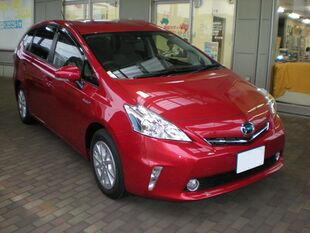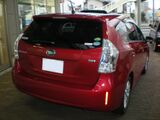Engineering:Daihatsu Mebius
| Daihatsu Mebius (ZVW41N) | |
|---|---|
 Daihatsu Mebius S (pre-facelift) | |
| Overview | |
| Manufacturer | Toyota |
| Also called | Toyota Prius V |
| Production | April 2013 – February 2021 |
| Assembly | Japan: Toyota, Aichi (Takaoka plant) |
| Body and chassis | |
| Class | Compact MPV |
| Body style | 5-door wagon |
| Layout | Front-engine, front-wheel-drive |
| Platform | Toyota New MC platform |
| Related | Toyota Prius (XW30) |
| Powertrain | |
| Engine | 1798 cc 2ZR-FXE I4 (petrol hybrid) |
| Electric motor | 60 kW (80 hp; 82 PS) 5JM AC synchronous |
| Power output | 73 kW (98 hp; 99 PS) (petrol engine only); 100 kW (134 hp; 136 PS) (combined system output)[1] |
| Transmission | 1-speed planetary gear |
| Dimensions | |
| Wheelbase | 2,780 mm (109.4 in) |
| Length | 4,615–4,645 mm (181.7–182.9 in) |
| Width | 1,775 mm (69.9 in) |
| Height | 1,575–1,600 mm (62.0–63.0 in) |
| uk|uk|Kerb|Curb}} weight | 1,450–1,460 kg (3,197–3,219 lb) |
The Daihatsu Mebius (Japanese: ダイハツ・メビウス Hepburn: Daihatsu Mebiusu) is Daihatsu's second hybrid electric car after the XV50 series Altis (a rebadged Toyota Camry). The Mebius is mechanically identical to the Toyota Prius v compact MPV (although unlike the Prius v, there is no 7-seater version), providing Daihatsu retailers with a larger vehicle than their usual kei class offerings. The car was only marketed in Japan from 2013 to 2021.
Minor changes appeared in November 2017 for both exterior and interior. The 4.2-inch TFT head unit and LED headlights became standard for every models. Toyota Safety Sense became standard in November 2017.
The name "Mebius" refers to the Möbius strip, sometimes spelled as "Moebius".
Powertrain
The Mebius' powertrain uses the same 1.8-litre Atkinson cycle petrol four-cylinder engine used in the conventional Prius, a 60 kW traction motor, and shares the Prius’s Hybrid Synergy Drive system and the same 201 volt nickel-metal hydride battery pack.[2][3][4]
Toyota introduced some refinements unique to the Prius v powertrain. These refinements include a new "Pitch and Bounce" motor control that the Prius v automatically employs on undulating roads and the refined control was designed to improve ride comfort and control. Because the Prius v is a larger vehicle with greater load capacity, suspension components were redesigned to improve handling and ride quality. "Pitch and Bounce" control works with the vehicle’s suspension to cancel longitudinal oscillation when the Prius v is driven over uneven surfaces.[4]
The Mebius also includes a redesigned engine coolant heating structure surrounding the vehicle’s catalytic converter and the exhaust heat recirculation system has been refined to reduce engine warm-up time and improve occupant heater response time in cold weather. A switch valve electronically controls coolant recirculation through the exhaust heat recirculation system.[4]
Gallery
See also
References
- ↑ "Toyota Reveals Prius Family of Vehicles at the North American International Auto Show". Press release Toyota USA Newsroom. 2011-01-10. http://pressroom.toyota.com/article_display.cfm?article_id=2840. Retrieved 2011-04-03.
- ↑ Jensen, Cheryl (2011-01-10). "With Prius V, Toyota’s Marquee Hybrid Tries On New Silhouette". The New York Times. http://wheels.blogs.nytimes.com/2011/01/10/with-prius-v-toyotas-poster-child-tries-on-new-silouhette/?scp=1&sq=Toyota%20prius%20V&st=cse. Retrieved 2011-01-15.
- ↑ Chris Shunk (2011-01-10). "Detroit 2011: Toyota Prius family adds a V for volume". Autoblog. http://www.autoblog.com/2011/01/10/toyota-prius-v-detroit-2011/. Retrieved 2011-01-15.
- ↑ 4.0 4.1 4.2 Jack Rosebro (2011-05-24). "Toyota previews Prius v; first expansion of planned Prius "family"". Green Car Congress. http://www.greencarcongress.com/2011/05/priusv-20110524.html. Retrieved 2011-05-24.
External links






